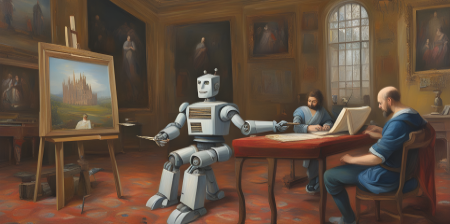


The AI Revolution



The AI Revolution

As AI technology continues to evolve, image content and processing LLMs have emerged as a promising area of research. These models are designed to generate images from textual descriptions and process images to extract information. They have the potential to revolutionize the way we interact with images and automate many tasks that previously required human intervention.
One of the most significant advancements in this field is the development of DALL-E by OpenAI. It is an LLM that can generate images from textual descriptions. For instance, given a prompt such as “an armchair in the shape of an avocado”, DALL-E can generate an image of an armchair that looks like an avocado1. Another example is CLIP developed by OpenAI, which can generate captions for images based on a given prompt.
LLMs have also been used for image processing. For example, Detectron2 developed by Facebook can detect objects in images and segment them. Another example is DeepLabV3+, which is an LLM that can perform semantic segmentation on images.
LLMs are used for image classification. For instance, ViT developed by Google can classify images into different categories such as animals, plants, and vehicles. Another example is ResNet, which is an LLM that can classify images into different categories such as food, people, and nature.
An increasingly significant use for LLMs is image generation. For example, StyleGAN2 developed by NVIDIA can generate high-quality images of faces based on a given prompt. Another example is BigGAN, which is an LLM that can generate high-resolution images of animals.
Extending on from image generation is the use of LLMs for image editing. For instance, GauGAN developed by NVIDIA can edit images based on textual descriptions. Another example is DeepRemaster, which is an LLM that can restore old videos and photos.
LLMs can be been used for animation and video editing & generating. For example, MidJourney is an LLM that can generate videos of AI-generated images. It can create a short movie of your initial image grid being generated and send a link to the video to your Direct Messages. Another example is DALL-E 2, which is an LLM that can generate animations from textual descriptions.
LLMs perform image-to-image translation. For instance, CycleGAN developed by UC Berkeley can translate images from one domain to another. Another example is Pix2Pix, which is an LLM that can generate realistic images from sketches.
LLMs have also been used for image inpainting. For example, DeepFillv2 developed by Baidu Research can fill in missing parts of an image based on its context. Another example is Context Encoder, which is an LLM that can fill in missing parts of an image based on its surrounding pixels.
LLMs are used for image super-resolution. For instance, ESRGAN developed by Xinntao Yan can enhance the resolution of low-quality images. Another example is SRGAN, which is an LLM that can generate high-resolution images from low-resolution ones.
These systems demonstrate the potential of LLMs for creating engaging and interactive experiences for users. However, they also highlight the need for responsible development and deployment of these technologies. As AI technology continues to advance, it is essential that we consider the ethical implications of these systems and ensure that they are developed in a way that benefits society as a whole.
If you want to learn more about image content and processing LLMs available on the internet or as installed applications, I recommend checking out this article on Unite.AI that provides a list of the best open-source LLMs in 2023 with detailed descriptions and use cases.
